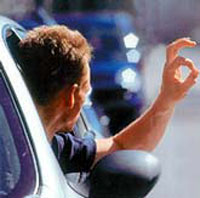Body language originates from animal communication
The secrets of body language

The language of gestures or body language is a form of communication using body movements or gestures instead of, or in addition to, sounds, verbal language, or other forms of communication. In everyday speech and popular psychology, the term is most often applied to body language that is considered involuntary even though the distinction between voluntary and involuntary body language is often controversial. For example, a smile may be produced either consciously or unconsciously.
Origins of body language
The relation of body language to animal communication has often been discussed. Body language is a product of both genetic and environmental influences. Blind children will smile and laugh even though they have never seen a smile. The ethologist Iraneus Eibl-Eibesfeldt claimed that a number of basic elements of body language were universal across cultures and must therefore be fixed action patterns under instinctive control. Some forms of human body language show continuities with communicative gestures of other apes, though often with changes in meaning. More refined gestures, which vary between cultures (for example the gestures to indicate "yes" and "no"), must be learned or modified through learning, usually by unconscious observation of the environment.
Social uses
Body language is important in one-on-one communications, and may be even more important in group communications. In group situations, often only one person at a time is speaking, while non-verbal communication is coming from each individual in the group. The larger the group, the more impact body language may have.
Body language is a factor in human courtship as a subconscious or subtle method of communication between potential mates. Researchers such as Desmond Morris have extensively studied and reported on courtship behaviour.
The following are examples of body language which can be very useful in communication and will help you to understand better what other people want to say to you.
- Standing with hands on hips means readiness or aggression.
- If a person is sitting with legs crossed with a foot kicking slightly this means that he is bored to death.
- Arms crossed on chest means defensiveness.
- If someone is holding a hand on a cheek this means that he is thinking or evaluating something.
- Touching, slightly rubbing nose means rejection, doubt, lying.
- Head resting in hand, eyes downcast also means boredom.
- When people rub their hands they usually anticipate something.
- When a person ia sitting with hands clasped behind head and crossed legs this means that he is confident and feels superiority.
- Tilted head means interest.
- When someone is stroking his chin that means that he or she is making decision.
Sources: deltabravo.net, wikipedia.com
Discuss this article on Pravda.Ru English Forum
Subscribe to Pravda.Ru Telegram channel, Facebook, RSS!


